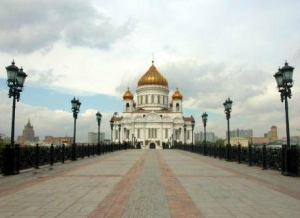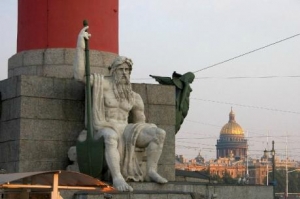Moscu +7-495-505-63-25
St. Petersburg +7-812-309-57-60
Catedral de Jesucristo el Salvador
15 Volkhonka St.

On December 25, 1812 Russian Emperor Alexander I signed an order, according to which it was supposed to build a temple dedicated to Russia's victory over Napoleon in Moscow. The new temple was to symbolize the feat of Russian people and to become a gratitude to Providence for saving Russia.
The author of the first project of the temple was Alexander Vitberg who suggested putting up the cathedral on the Vorobievy Hills (Sparrow Hills). According to his plan, the cathedral was to consist of the three parts symbolizing the Incarnation, the Transfiguration and the Resurrection. The lower part of the cathedral was supposed to be the burial place for those who died in the battles of the war of 1812. The temple was solemnly laid out, but Vitberg's project was never brought to life. The mountains started to sink under the construction weight, and Nicolas I who became Russian Tsar after Alexander I found Vitberg's project unrealizable. Instead of Vitberg, Konstantin Ton was appointed the architect of the cathedral.
It was decided to put up the temple on the site of Alexeevsky convent. There was a legend that one of the nuns was so desperate about moving the convent that she cursed the future cathedral and foretold that it would not survive for more than 50 years. Anyway, the place for cathedral construction was perfect: the temple could be seen from any part of Moscow, and neighboring with the Kremlin symbolized the connection of the new Cathedral of Christ the Savior with Russian history and culture.
It took about 40 years (1839-1883) to build and decorate the Cathedral of Christ the Savior. On May 26, 1883, the temple was solemnly consecrated in presence of Emperor Alexander III and his family.
The outside part of the cathedral shaped as a cross was decorated with the double row of marble high relieves made by sculptors Clodt, Loginovsky, and Ramazanov. The twelve entrance doors were made of bronze and decorated with the images of saints made by the famous sculptor, Prince F. Tolstoy. The contemporaries admired the size of the cathedral that could house up to 10,000 persons.
The rich interior decoration of the Cathedral of Christ the Savior included wall paintings and adornments made of semi-precious stones (porphyry and Italian marble). Famous Russian painters such as V. Vereshagin, V. Surikov, I. Kramskoi decorated the cathedral. The temple was surrounded by the gallery that became the first museum of the war of 1812. On the gallery walls there were the marble plaques on which all the battles of Russian army were mentioned, and the names of commanders, excelled officers and solders were written.
The first Cathedral of Christ the Savior existed 48 years, so that some people recalled the curse of the nun. The magnificent cathedral did not match the principles of atheism and irritated the Soviet government. Iosif Stalin ordered to destroy the temple. The cathedral of Christ the Savior was blown up on December 5, 1931.
On the site of the cathedral it was decided to construct a giant tower topped with the statue of Vladimir Lenin — the Soviet Palace. However, World War II interrupted the plans. In 1958-1960s the foundation pit dug for the palace was used for the open swimming pool «Moscow».
The swimming pool existed for 30 years. At the end of the 1980s it was suggested to reconstruct the cathedral. In July, 1992 the President of Russia, Boris Eltsin issued an edict, according to which the Fund of Moscow revival was founded. In the list of objects to reconstruct the Cathedral of Christ the Savior occupied the first position. Unbelievably impetuous terms of construction works allowed consecrating the restored cathedral in 2000.
Nearest hotels
President
Calle Bolshaya Yakimanka, 24
En 1982 en la orilla del Moscova, en el mismo centro administrativo y de negocios de la capital, apareció el hotel de
de 0
por noche
Kebur Palace
Calle Ostozhenka, 32
El hotel Kebur Palace de 31 habitaciones confortables es el variante para los que prefieren la comodidad y serenidad
de 91.12
por noche
Arbat
Calle Plotnikov, 12
El hotel de cuatro estrellas Arbat se sitúa en el centro de Moscú, no lejos de las calles Nuevo Arbat y Viejo Arbat y
de 0
por noche
Park Inn Sadu
17, B.Polyanka str., bld.1
The Park Inn Sadu hotel belonged to Park Inn hotel net was opened in Moscow. The hotel is ideally situated in the
de 0
por noche
Bagration
7A Sechenovsky Lane
The Bagration hotel is located in the heart of Moscow, near the famous attractions of the capital such as the
de 0
por noche
Atracciones de Moscu
- Monuments

































